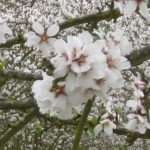 Almonds are deciduous trees native to the Indian subcontinent, North Africa, and the Middle East including Syria and Palestine. The upright tree grows 25-40′ tall and has wide spreading branches and rough gray bark. The bright green leaves are simple and 3-5″ long. The white to pale pink flowers are 1-2″ across and have 5 petals. They appear singly or in pairs in spring before the leaves emerge and give way to oblong, brown fruits, 1 ½ inches long.
Almonds are deciduous trees native to the Indian subcontinent, North Africa, and the Middle East including Syria and Palestine. The upright tree grows 25-40′ tall and has wide spreading branches and rough gray bark. The bright green leaves are simple and 3-5″ long. The white to pale pink flowers are 1-2″ across and have 5 petals. They appear singly or in pairs in spring before the leaves emerge and give way to oblong, brown fruits, 1 ½ inches long.
The almond appears in 9 verses of the Bible all in the Old Testament:
Genesis 30:37 Jacob follows the dictates of some ancient folklore:
“Then Jacob took fresh rods of poplar and almond and plane, and peeled white streaks in them, exposing the white of the rods.”
Genesis 43.11 Jacob orders his sons to take prized foods as presents to Joseph in Egypt.
“Then their father Israel said to them, “If it must be, then do this: Put some of the best products of the land in your bags and take them down to the man as a gift—a little balm and a little honey, some spices and myrrh, some pistachio nuts and almonds.”
Exodus: Moses gives directions for carving the candlesticks
25:33 “three cups shaped like almond blossoms, each with calyx and petals, on one branch, and three cups shaped like almond blossoms, each with calyx and petals, on the other branch—so for the six branches going out of the lampstand.”
25:34 “On the lampstand itself there shall be four cups shaped like almond blossoms, each with its calyxes and petals.”
37:19 “ three cups shaped like almond blossoms, each with calyx and petals, on one branch, and three cups shaped like almond blossoms, each with calyx and petals, on the other branch—so for the six branches going out of the lampstand.”
37:20 “On the lampstand itself there were four cups shaped like almond blossoms, each with its calyxes and petals.”
Numbers 17.8 Moses placed 12 staffs one for each tribe, in the tent of the covenant law.
“ The next day Moses entered the tent and saw that Aaron’s staff, which represented the tribe of Levi, had not only sprouted but had budded, blossomed and produced almonds.
Ecclesiastes 12:5 Because the almond tree blooms in winter before the leaves appear it was considered a symbol of old age. Here an almond tree in full bloom is compared to the white hair of old age.
“when one is afraid of heights, and terrors are in the road; the almond tree blossoms, the grasshopper drags itself along and desire fails; because all must go to their eternal home, and the mourners will go about the streets;”
Jeremiah 1:11 The branch of almond may represent the idea of acting promptly.
“The word of the Lord came to me, saying, “Jeremiah, what do you see?” And I said, “I see a branch of an almond tree.”
Almond trees need hot summer temperatures, dry air, and wet winters to set good fruit and thrive in full sun and fertile, deep, well-drained soil in USDA Hardiness Zones 6-9. They do not tolerate alkali or salt and are susceptible to mites, peach twig borer, brown rot, shot-hot fungus, and oak-root fungus. Propagation is by seed with cold stratification, cuttings, and layering. Trees begin bearing fruit at 3 years of age.
The genus name, Prunus, comes from the Greek word προύνη meaning plum, a prominent member of this genus. The genus name and specific epithet, amygdalus, is the ancient Latin name for almond and is no longer used as a genus name. The specific epithet, dulcis, is the Latin word meaning sweet. The specific epithet, communis, is the Latin word meaning common or general.